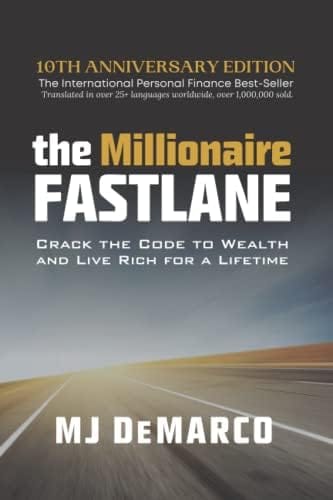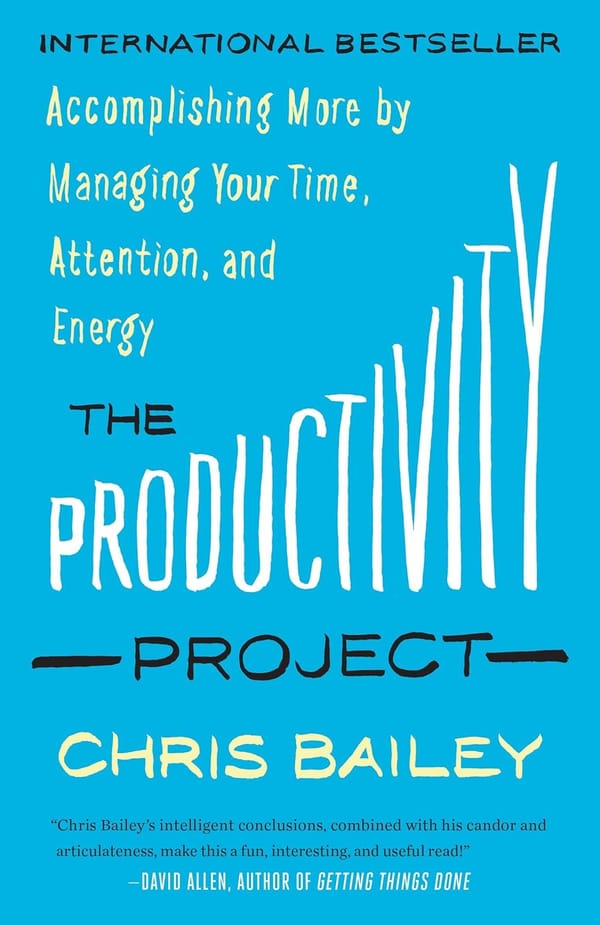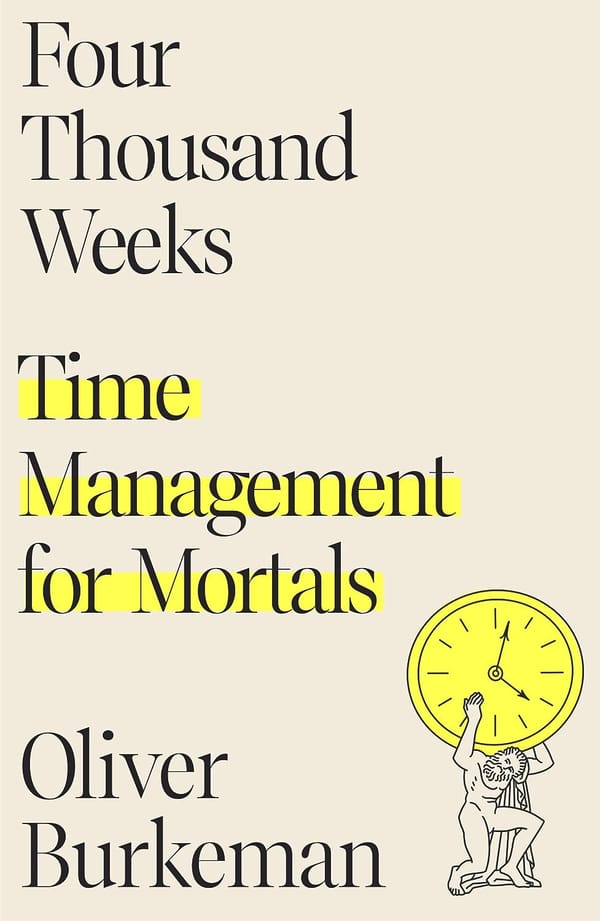The Millionaire Fastlane - Book Notes
Revolutionize your approach to wealth with 'The Millionaire Fastlane'—a roadmap to financial freedom that defies societal norms. Learn the secrets of the Fastlane, prioritize time over money, and unleash the power of unconventional thinking to accelerate your journey to prosperity.
If you enjoyed my review, consider supporting me by using the affiliate links below to purchase the book. Your kindness fuels my passion for sharing captivating reads with you!
🚀 The Book in 3 Sentences
- "The Millionaire Fastlane" challenges conventional notions of wealth-building, advocating for a "Fastlane" approach to financial success, characterized by unconventional thinking and entrepreneurial ventures.
- The book emphasizes the importance of time as a valuable asset and provides a framework, including the Five Fastlane Commandments, to guide individuals toward building wealth efficiently.
- It encourages readers to break free from societal conditioning, prioritize time over money, and pursue ventures that align with the principles of control, entry, need, time, and scale.
👱 Who Should Read it?
I recommend "The Millionaire Fastlane" for individuals seeking a financial paradigm shift, entrepreneurs aiming for unconventional success, and anyone eager to break free from societal normas and fast-track their journey to wealth.
🍀 How the Book Changed Me
I've been playing a long time with the thought of creating my own business. This book finally gave me the push to get serious about it, and I decided to pursue this life-long dream of mine.
✍️ Top 3 Quotes
- "If you want to push beyond average results produced by average people, you’ll need to adopt an uncommon approach that doesn’t fall in the favor of 'everyone.' Extraordinary wealth will require you to have extraordinary beliefs."
- "Your Lifespan = Free Time + Indentured Time. Money buys free time and eliminates indentured time. The right time is free time; indentured time is the wrong time."
- "The larger the habitat, the greater the potential speed, or leverage, of your Fastlane. If 'units sold' has a ceiling, you stifle leverage. Without leverage, you can’t create wealth exponentially."
🔨 3 Action Points
- Challenge Social Conditioning:
Evaluate your beliefs and question societal norms that may limit your potential. Embrace an uncommon approach and be prepared to deviate from the expectations of the majority to achieve extraordinary results. - Prioritize Time Over Money:
Reflect on your daily activities and expenditures, considering the trade-off between free time and indentured time. Work towards eliminating activities that consume your time without contributing significantly to your goals. - Apply Fastlane Commandments in Business:
If you're an entrepreneur, assess your business against the Five Fastlane Commandments – Control, Entry, Need, Time, and Scale. Ensure you have control over your business, address entry barriers, focus on solving needs, optimize your use of time, and strive for scalability.
📗 Summary & Notes
Wealth Paths
"The Millionaire Fastlane" challenges conventional beliefs about wealth-building, arguing against the slow and steady approach of traditional financial advice. It exposes the flaws in the traditional wealth equation and introduces the concept of the Fastlane as an alternative path to financial success. The book categorizes three distinct paths to wealth: the Sidewalk, representing a lack of financial planning and perpetual lifestyle servitude; the Slowlane, characterized by delayed gratification and reliance on uncontrollable limited leverage; and the Fastlane, an entrepreneurial approach with controllable unlimited leverage.
Process Over Events
The narrative underscores the significance of process over events, illustrating that wealth is a culmination of trial, risk, hard work, and sacrifice. It cautions against the allure of looking wealthy, emphasizing the detrimental impact on freedom, health, and relationships. The book posits that genuine wealth is not merely material possessions but is derived from family, fitness, and freedom.
Fastlane Strategy
The author argues that societal norms often lead people towards financial mediocrity. To achieve extraordinary wealth, one must overcome the conditioned mindset and embrace an uncommon approach. This involves turning away from naysayers and those who doubt unconventional goals.
The Fastlane strategy is presented as a business and lifestyle choice characterized by controllable unlimited leverage (CUL), in contrast to the Slowlane's uncontrollable limited leverage (ULL). The book introduces the Fastlane wealth equation, focusing on net profit and asset value. It highlights the power of money trees, referring to business systems that survive on their own and generate passive income.
Choices and Decision-Making Tools:
The book concludes by stressing the significance of choices in shaping one's financial destiny and provides practical tools like Worse Case Consequence Analysis (WCCA) and Weighted Average Decision Matrix (WADM) to aid decision-making.
Valuing Time
The book stresses the importance of time as the most valuable asset. It introduces the concept of free time and indentured time, emphasizing that managing time poorly can lead to financial struggles.
Example: If someone spends the majority of their time on a job they dislike, they are in indentured time. To transition to free time, one might invest in a business that generates passive income, reducing the need for traditional employment.
Continuous Reinvention and Education
The idea is that staying ahead in the Fastlane requires a commitment to continuous learning and personal growth. The acquisition and application of new knowledge are essential for navigating the ever-changing business landscape.
Example: In the tech industry, staying relevant and successful requires constant learning as new technologies emerge. Entrepreneurs who continuously update their skills are better positioned for success.
Commitment over Comfort
Commitment is highlighted as a key factor in achieving success. The book encourages readers to trade short-term comforts for the promise of long-term gains, embracing failure as a natural part of the journey.
Example: An entrepreneur who quits a stable job to start a business is making an intelligent risk. The upside could be financial success, while the downside might involve temporary financial struggles.
The Five Fastlane Commandments (CENTS Framework)
The book introduces five commandments that serve as a framework for building a successful business - Control, Entry, Need, Time, and Scale. These commandments guide entrepreneurs in creating businesses that align with Fastlane principles.
- Control: The level of influence and authority over the business. High control offers flexibility; low control may lead to dependence.
- Entry: The ease or difficulty of entering a market. Low entry barriers facilitate market penetration; high barriers limit competition.
- Need: The demand for the product or service. High need indicates strong market demand.
- Time: The speed at which the business can produce results. Faster results lead to quicker profits and scalability.
- Scale: The potential for business growth and expansion. Scalable businesses can increase output without proportionally increasing costs.
The Three I's: Internet, Innovation, Intentional Iteration
The author categorizes the most potent Fastlane roads as the Three I's. Internet-based businesses, innovative ventures, and intentional iteration (repeating successful processes) are presented as powerful strategies.
Example: An entrepreneur launching an online subscription service (Internet) that offers a unique and innovative product, and then iteratively improving the service based on customer feedback, follows the Three I's approach.
Identifying Opportunity
The book defines opportunity as a solution to an unmet need or inconvenience. It suggests looking for areas where improvement or simplification is possible. E.g. Identifying a common complaint, such as "I hate waiting in long lines," might lead to an opportunity to create a business that streamlines the checkout process or offers a virtual queuing system.
Superior Unexpected Customer Service (SUCS)
The concept emphasizes surpassing customer expectations, turning them into loyal advocates. SUCS aims to create satisfied customers who not only return but also become promoters of the business.
Building a Brand and Unique Selling Proposition (USP)
The book emphasizes the importance of differentiating a product or service through a Unique Selling Proposition (USP) to counteract commoditization and create brand value.
A brand is not just a logo or a product; it's the emotional connection and perception consumers have about a business. It encompasses values, reputation, and the overall experience associated with a company or product.
Importance of Building a Brand and USP:
- Differentiation: In a crowded market, a strong brand and USP help a business stand out, attracting attention and fostering customer loyalty.
- Trust and Credibility: A well-established brand builds trust, as consumers associate it with quality and reliability.
- Customer Connection: Emotional branding through a compelling story or shared values creates a lasting connection with customers.
- Competitive Edge: A unique selling proposition provides a competitive advantage by offering something competitors do not.
Translating Features into Benefits
The book emphasizes the need to focus on benefits rather than features when marketing a product or service. It suggests a four-step process to translate features into customer-centric benefits.
- Identify Features: Begin by listing the distinctive features of the product or service. These are the tangible aspects or characteristics that differentiate it from others in the market. Features can include specifications, functionalities, or any unique attributes that define what the product or service can do.
- Understand Customer Needs: Conduct thorough market research to understand the needs, desires, and pain points of the target audience. Identify what challenges or problems customers are trying to solve and what benefits they seek from a product or service.
- Connect Features to Benefits: For each feature identified, analyze how it directly addresses a customer's need or provides a solution. Transform each feature into a corresponding customer-centric benefit by answering the question: "What value does this feature add to the customer?"
- Communicate Effectively: Craft marketing messages, product descriptions, or promotional materials that emphasize the translated benefits rather than just listing features. Use language that resonates with the target audience, focusing on how the product or service improves their lives, solves problems, or fulfills their aspirations.
Understanding the Power of Price:
The author discusses the psychological impact of pricing on perceived value. It suggests that price is not just a number but a tool that conveys the value of a product or service. Luxury brands often use higher pricing as a strategy to convey exclusivity and superior quality, creating a perception of increased value.
Conclusion
"The Millionaire Fastlane" serves as a catalyst for a financial revolution, urging us to rethink our approach to wealth-building. It's more than a book; it's a call to action, an invitation to embrace an unconventional mindset and take charge of our financial destinies. As we apply the principles outlined within its pages, may we find ourselves not just accumulating wealth, but living a life rich in freedom, fulfillment, and the pursuit of our true passions. The Fastlane awaits, and the choice to embark on this transformative journey is ours to make.



